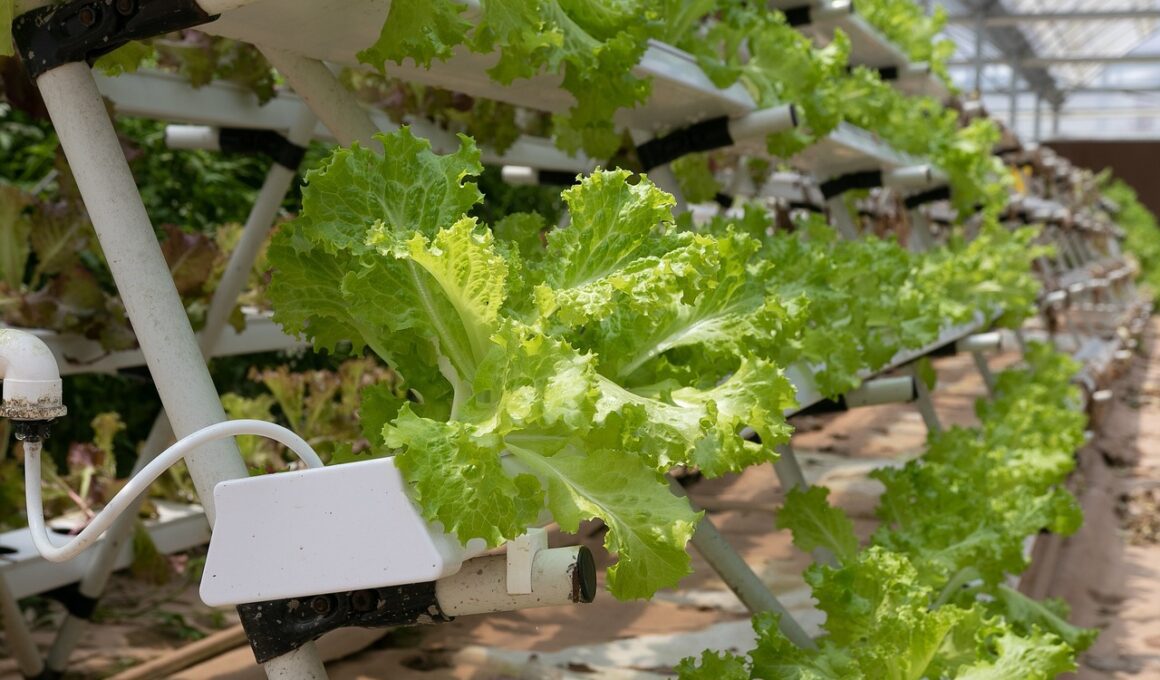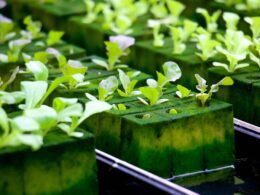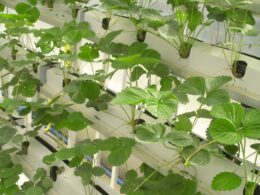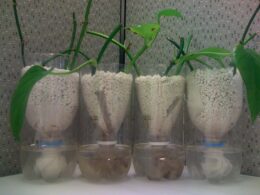Are you curious about the nutrient content of your hydroponic lettuce? While hydroponic farming methods have gained popularity in recent years, there is a concern about the lack of certain nutrients in hydroponic produce, specifically phytochemicals.
These compounds are essential for human health and have been linked to reducing the risk of chronic diseases, such as cancer and cardiovascular disease.
In this article, we will explore the importance of phytochemicals in human health and the lack of these compounds in hydroponic lettuce. We will also compare the nutrient content of hydroponic and conventional lettuce and discuss ways to increase phytochemical content in hydroponic lettuce.
By the end of this article, you will have a better understanding of the nutrient content of your hydroponic lettuce and how to improve it for optimal health benefits.
Understanding Hydroponic Farming Methods
If you’ve ever seen a garden floating in the air with plants growing out of tubes, then you’ve witnessed one of the many unique methods of farming that exists today. This method is called hydroponic farming, and it involves growing plants in water without soil.
Vertical farming is a type of hydroponic farming that involves stacking plants on top of each other in a tower-like structure. This allows farmers to grow more plants in a smaller space, making it a popular method for urban areas with limited land.
One of the most common techniques used in hydroponic farming is called the nutrient film technique. This involves pumping a thin layer of nutrient-rich water over the roots of the plants. The water is then collected and recirculated, ensuring that the plants always have access to the nutrients they need to grow.
However, despite the use of nutrient-rich water, hydroponic lettuce is often lacking in one key nutrient: calcium. Calcium is an essential nutrient for plant growth and development, and it plays a crucial role in cell structure and function.
While most hydroponic nutrient solutions contain calcium, it can be difficult for plants to absorb it without the presence of soil. As a result, hydroponic lettuce is often deficient in calcium, which can lead to weak stems, leaf tip burn, and poor overall plant growth.
To combat this issue, some hydroponic farmers add calcium supplements to their nutrient solution or use a different growing medium that contains calcium.
Importance of Phytochemicals in Human Health
Phytochemicals are essential for a healthy body and can be found in the vibrant colors of fruits and vegetables. These natural compounds are responsible for giving plant foods their rich hues, flavors, and aromas. However, their importance goes beyond aesthetics.
Phytochemicals have been linked to numerous health benefits, such as reducing inflammation, preventing chronic diseases, and boosting the immune system. Unfortunately, many people don’t consume enough phytochemicals in their diets, which can lead to a phytochemical deficiency.
This is where phytochemical supplements can be helpful. While supplements shouldn’t replace a healthy diet, they can provide an extra boost of these important compounds that may be lacking in your food. However, it’s important to choose supplements wisely and always consult with a healthcare professional before adding them to your routine.
Hydroponic lettuce, like many other hydroponic crops, may not contain as many phytochemicals as conventionally grown produce due to differences in growing methods. However, this doesn’t mean that hydroponic lettuce is not a healthy option. It’s still a great source of vitamins and minerals, and can be a convenient and sustainable way to add more leafy greens to your diet.
Just remember to vary your diet and incorporate a variety of colorful fruits and vegetables to ensure that you’re getting a diverse range of phytochemicals.
Lack of Phytochemicals in Hydroponic Lettuce
You may be surprised to learn that the vibrant green lettuce in your hydroponic garden may not have as many health-boosting compounds as you thought. While hydroponic lettuce is a popular choice for growing fresh greens, it lacks the phytochemical benefits found in soil-grown lettuce.
Phytochemicals are natural compounds found in plants that have been linked to reduced risk of chronic diseases such as cancer, heart disease, and Alzheimer’s. Unfortunately, hydroponic growing methods do not provide the same soil-based environment that helps plants produce these phytochemicals.
The lack of soil also means that hydroponic lettuce may not have as many nutrients as traditional soil-grown lettuce. But there are alternative growing methods that can help produce more nutrient-dense and phytochemical-rich lettuce. One such method is aquaponics, which combines hydroponics with fish farming to create a symbiotic growing system that produces healthier and more sustainable crops.
Incorporating alternative growing methods can not only provide more health benefits, but also help reduce the environmental impact of traditional agriculture. While hydroponic gardening may be convenient, it’s important to consider the nutritional value of the crops we are growing. By exploring alternative methods such as aquaponics, we can ensure that we are growing the healthiest and most sustainable crops possible.
Comparison of Nutrient Content in Hydroponic and Conventional Lettuce
So you’re curious about the nutrient content and taste of hydroponic lettuce compared to conventional lettuce?
Well, in addition to lacking phytochemicals, hydroponic lettuce may also have lower levels of certain nutrients such as calcium and magnesium.
On the other hand, some studies have shown that hydroponic lettuce can have a crisper texture and milder taste than conventionally grown lettuce.
Other Nutrients in Hydroponic Lettuce
There’s a lot more to hydroponic lettuce than just its crisp green leaves. Did you know that it’s also a great source of vitamins and minerals? Apart from nitrogen, potassium, and phosphorus, which are the essential nutrients for plant growth, hydroponic lettuce also contains other nutrients that are beneficial for your body.
Here are some of the other nutrients that you can get from hydroponic lettuce:
- Vitamin C: Hydroponic lettuce is a good source of vitamin C, which is an antioxidant that helps boost your immune system.
- Vitamin K: This nutrient is essential for blood clotting and bone health. Hydroponic lettuce is rich in vitamin K, which can help prevent osteoporosis and other bone-related diseases.
- Iron: Iron is an important mineral that helps transport oxygen throughout your body. Hydroponic lettuce contains a good amount of iron, which can help prevent anemia.
As you can see, hydroponic lettuce is not just a tasty addition to your salad, but it’s also packed with nutrients that are essential for your health. So, the next time you eat a bowl of hydroponic lettuce, you can enjoy it even more knowing that it’s not just delicious, but it’s also good for you.
-
Fiber: Fiber is important for a healthy digestive system. Hydroponic lettuce contains fiber, which can help prevent constipation and other digestive problems.
-
Calcium: Calcium is essential for strong bones and teeth. Although hydroponic lettuce doesn’t contain as much calcium as dairy products, it still provides a good amount of this mineral, which is important for overall health.
Difference in Taste and Texture
If you’re used to the crunch and crispness of traditional soil-grown lettuce, you may notice a difference in taste and texture when trying hydroponic lettuce. While hydroponic lettuce can still be crisp and refreshing, some people find that it has a milder flavor compared to soil-grown lettuce. This is because hydroponic lettuce lacks the complex flavors and nutrients that come from the soil.
However, despite the difference in taste preference, hydroponic lettuce offers texture variations that can be enjoyed by many. The controlled environment of hydroponic systems can produce lettuce with a consistent texture, which is preferred by some people. Additionally, hydroponic lettuce tends to have a more tender texture compared to soil-grown lettuce, which can be appealing to those who prefer a softer bite.
Overall, while hydroponic lettuce may taste slightly different than soil-grown lettuce, it offers unique texture variations that can be appreciated by many.
Ways to Increase Phytochemical Content in Hydroponic Lettuce
To increase the phytochemical content in your hydroponic lettuce, you can consider adding nutrient supplements such as potassium, calcium, and iron.
Alternative farming techniques like using LED lights or adjusting the pH levels can also help.
Additionally, educating consumers about the importance of phytochemicals in their diet can increase demand for high-quality hydroponic produce.
Nutrient Supplements
Adding supplements is essential for optimal growth and health of lettuce in hydroponic systems. While hydroponic systems offer numerous benefits over traditional soil-based growing, the lack of natural nutrients in the water can lead to nutrient deficiencies in plants.
To address this issue, hydroponic nutrient supplements are used to provide the necessary nutrients for optimal growth and development of lettuce plants. These supplements come in various forms, including liquid concentrates, powders, and tablets.
It’s important to follow the recommended dosage provided by the manufacturer, as over-supplementation can lead to toxicity and damage to the plants. Additionally, it’s important to regularly monitor the nutrient levels in the water and adjust the dosage accordingly to ensure that the lettuce plants are receiving the optimal amount of nutrients.
By using hydroponic nutrient supplements, you can ensure that your lettuce plants are receiving the necessary nutrients for healthy growth and optimal phytochemical content.
Alternative Farming Techniques
You may be interested in exploring alternative farming techniques that offer unique benefits and challenges.
Vertical farming is a technique that involves growing crops in vertically stacked layers, using artificial lighting and a controlled environment. This method allows for more efficient use of space, as well as a reduced need for pesticides and herbicides. Additionally, vertical farming can help reduce transportation costs and minimize the environmental impact of farming practices.
Sustainable agriculture is another alternative farming technique that focuses on using farming practices that are environmentally friendly and promote the long-term health of the soil. This approach involves using crop rotation, organic fertilizers, and natural pest control methods. By using sustainable agriculture, farmers can reduce their reliance on chemical fertilizers and pesticides, which can have negative impacts on the environment and human health. Additionally, sustainable agriculture can help improve soil health, which can lead to higher crop yields and better quality produce.
Importance of Consumer Education
Learning about the importance of consumer education can help individuals make informed decisions about the food they eat and the impact it has on the environment.
In particular, consumer awareness about nutrient deficiency in hydroponic lettuce is crucial. Hydroponic systems rely on nutrient solutions to grow plants, and if the solution is not properly balanced, plants may lack essential nutrients.
Consumers who are aware of this issue can make educated decisions about the products they choose to purchase. They can seek out hydroponic lettuce that has been grown using balanced nutrient solutions or opt for other varieties of lettuce that are not grown hydroponically.
By making these choices, consumers can support sustainable farming practices and ensure that they are consuming nutrient-rich foods that support their health and wellbeing.
Frequently Asked Questions
What are the benefits of hydroponic farming compared to traditional farming methods?
When it comes to farming, hydroponics has a lot of benefits over traditional methods. It’s incredibly efficient because the plants are grown in a nutrient-rich water solution, so they don’t need as much space or resources to grow. This makes it a great option for urban farming where space is at a premium.
Plus, hydroponic farms are much more sustainable than traditional ones, using less water and producing less waste. Overall, hydroponics is a great way to grow food in a way that’s good for the planet and good for your community.
How does the lack of soil in hydroponic farming affect the nutrient content of lettuce?
In hydroponic farming, there’s a lack of soil which affects the nutrient content of lettuce. Instead of soil, plants are grown in a water-based nutrient solution.
This soilless nutrient uptake method can result in a lack of certain nutrients that would typically be found in soil. To combat this, nutrient solution formulations are used to provide the necessary nutrients for plant growth.
While the lack of soil may seem concerning, rest assured that hydroponic lettuce is still a safe and nutritious option for consumption. In fact, hydroponic farming can provide a more controlled environment for plant growth, resulting in higher yields and potentially even more nutrient-dense produce.
Are there any negative health effects associated with consuming hydroponic lettuce with lower phytochemical content?
When it comes to hydroponic lettuce, there can be negative implications associated with consuming a product that has lower phytochemical content. Phytochemicals are important nutrients found in plants that provide numerous health benefits, such as reducing the risk of chronic diseases.
However, hydroponic farming can sometimes result in lower levels of phytochemicals due to the lack of soil. To combat this issue, nutrient supplementation can be added to hydroponic systems to boost the nutrient content of the lettuce.
So, while hydroponic lettuce may not have as many phytochemicals as traditionally grown lettuce, nutrient supplementation can help ensure that it is still a healthy and safe option for consumption.
Can hydroponic lettuce be fortified with phytochemicals through supplementation or genetic modification?
Looking to fortify your hydroponic lettuce with phytochemicals? You have two options: supplementation or genetic modification.
Supplementation involves adding phytochemicals to the nutrient solution, increasing the nutrient bioavailability for the plants. Genetic modification, on the other hand, involves altering the plant’s DNA to produce higher levels of phytochemicals naturally.
While both methods have potential, it’s important to consider the safety and ethical implications of genetic modification. By fortifying your hydroponic lettuce, you can ensure that you’re getting the maximum health benefits from your greens.
How does the cost of hydroponic lettuce compare to conventionally grown lettuce?
If you’re wondering about the cost of hydroponic lettuce compared to conventionally grown lettuce, you’ll be pleased to know that the market demand for hydroponic lettuce has been increasing steadily over the years. This increase in demand has led to a decrease in cost, making hydroponic lettuce more affordable for the average consumer.
While conventionally grown lettuce may still be cheaper in some areas, the benefits of hydroponic lettuce, such as its year-round availability and lack of pesticides, make it a worthwhile investment for those looking for a safer and healthier option.
Conclusion
Congratulations on completing this informative article! Now that you have a better understanding of hydroponic farming methods and the importance of phytochemicals in human health, it is clear that hydroponic lettuce lacks the same level of phytochemicals as conventional lettuce.
However, there are ways to increase the phytochemical content in hydroponic lettuce. By adjusting the nutrient solution, using different lighting techniques, and implementing stress-inducing methods, hydroponic farmers can increase the phytochemical levels in their lettuce.
So, next time you’re at the grocery store, consider choosing conventional lettuce to ensure you’re getting the full range of nutrients your body needs.









